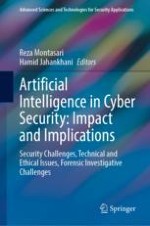
2021 | OriginalPaper | Chapter
Handling Novel Mobile Malware Attacks with Optimised Machine Learning Based Detection and Classification Models
Authors : Ali Batouche, Hamid Jahankhani
Published in: Artificial Intelligence in Cyber Security: Impact and Implications
Publisher: Springer International Publishing
Activate our intelligent search to find suitable subject content or patents.
Select sections of text to find matching patents with Artificial Intelligence. powered by
Select sections of text to find additional relevant content using AI-assisted search. powered by